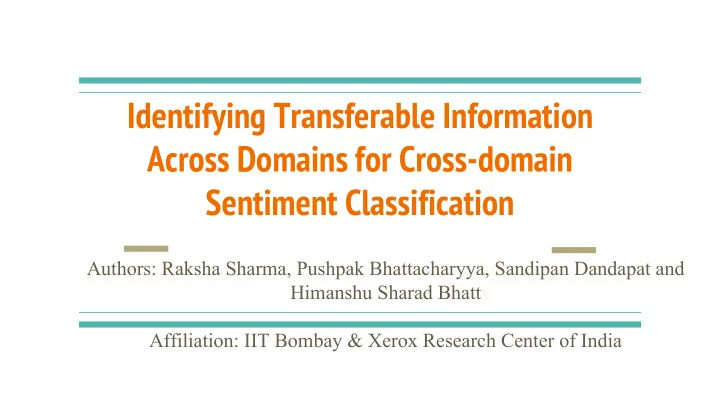

Identifying Transferable Information Across Domains for Cross-domain Sentiment Classification Authors: Raksha Sharma, Pushpak Bhattacharyya, Sandipan Dandapat and Himanshu Sharad Bhatt Affiliation: IIT Bombay & Xerox Research Center of India
Motivation - Getting manually labeled data in each domain for sentiment analysis is always an expensive and a time consuming task, cross-domain sentiment analysis provides a solution. - However, polarity orientation (positive or negative) and the significance of a word to express an opinion often differ from one domain to another. Changing Significance: “Entertaining, boring, one-n ote, etc.” are significant for classification in the movie domain. Changing Polarity: “Unpredictable plot of a movie” //Positive sentiment “Unpredictable behaviour of a machine” //Negative sentiment 2 raksha.sharma1@tcs.com
Problem Definition - Significant Consistent Polarity (SCP) words represent the transferable (usable) information across domains. We present an approach based on χ 2 test and cosine-similarity between context vector of - words to identify polarity preserving significant words across domains. - Furthermore, we show that a weighted ensemble of the classifiers enhances the cross-domain classification performance. 3 raksha.sharma1@tcs.com
Technique: Find SCP Significant Consistent Polarity (SCP): S ⋂ T //Transferable information from the source (S) to the target (T) for cross-domain SA. S: Significant words with their polarity orientation in the labeled source domain: � 2 test H 0 : ‘unpredictable’ has equal distribution in the positive and negative corpora H a : ‘unpredictable’ has significantly different count in either positive or negative corpus If X 2 score is greater than 3.85 => p-value ≤ 0.05 => Probability of the observed value given null hypothesis is true is less than 0.05 => Reject the Null hypothesis => ‘unpredictable’ has occurred significantly more often in one of the class with a � 2 score of 4.5 . => C wP > C wN , hence ‘unpredictable’ is positive 4 raksha.sharma1@tcs.com
Technique: Find SCP (2) T: Significant words with their polarity orientation in the unlabeled target domain: Significance: NormalizedCount t (Significant s (w)) > θ ⇒ Significant t (w) Polarity: Note: We construct a 100 dimensional vector for each candidate word from the unlabeled target domain data. Significant Consistent Polarity (SCP): S ⋂ T //Transferable information from the source to the target for cross-domain SA. 5 raksha.sharma1@tcs.com
Example: Inferred polarity orientation in the Target Domain Word Great Bad Polarity (Pos-pivot) (Neg-pivot) Horrible 0.25 0.31 Negative Awful 0.08 0.31 Negative Terrible 0.05 0.21 Negative Fantastic 0.23 0.04 Positive Amazing 0.24 0.04 Positive Wonderful 0.25 0.01 Positive Cosine-similarity score with the Pos-pivot (great) and Neg-pivot (bad), and inferred polarity orientation of words in the movie domain. 6 raksha.sharma1@tcs.com
F-score for SCP words identification task E : Electronics Gold standard SCP words: Application of � 2 test in Available at: B : Books both the domains considering target domain is also http://www.cs.jhu.edu/~mdredze/datasets/sentiment/ind K : Kitchen labeled gives us gold standard SCP words from the ex2.html D : DVD corpus. No manual annotation. SCL: Structured Correspondence Learning (Bhatt et al., 2015) Figure-1: F-score for SCP words identification task (source -> target) with respect to gold standard SCP words. 7 raksha.sharma1@tcs.com
Domain Adaptation Algorithm C s (exampleDoc) = -0.07 (wrong prediction, negative) C t (exampleDoc) = 0.33 (correct prediction, positive) W s = 0.765 , W t = 0.712 8 raksha.sharma1@tcs.com
Cross-domain Results Sys1 Sys2 Sys3 Sys4 Sys5 Sys6 System Name: Transferred Info System-1: Common-unigrams D->B 62 64.2 67 66 76.5 78.5 System-2: SCL (Bhatt et al, 2015) System-3: SCP E->B 63 58.9 68.3 67 75.6 76.3 System-4: System-1 + iterations System-5: System-2 + iterations K->B 67 68.75 67.85 69 71.2 74 System-6: System-3 + iterations B->D 76 81 80.5 77 81.5 81.5 E->D 68 71 77.5 71.5 74 80.4 ❏ We obtained a strong positive K->D 69 69 74 71 75.2 77 correlation (r) of 0.78 between F-score (figure-1) and B->E 68 66 73 69 79 81.2 cross-domain accuracy K->E 76 75.75 80 78 81 82 (system-3). K->E 76 75.75 80 78 81 82 B->K 66 67.5 72 69 79.2 80.5 D->K 65.76 67 71 66 80 81 9 E->K 74.25 75 85.75 76 84 85.75 raksha.sharma1@tcs.com
Conclusion - Significant Consistent Polarity (SCP) words shows a strong positive correlation of 0.78 with the sentiment classification accuracy achieved in the unlabeled target domain. - Essentially, a set of less erroneous transferable features lead to a more accurate classification system in the unlabeled target domain. 10 raksha.sharma1@tcs.com
Recommend
More recommend